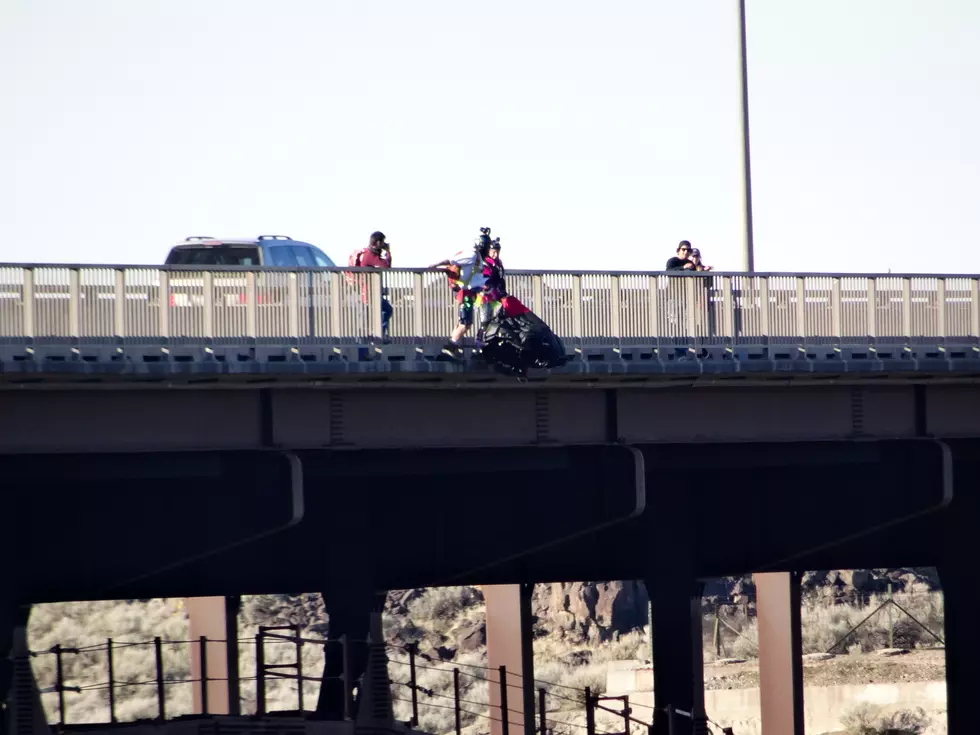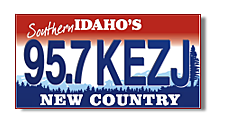
Perrine Bridge Turns 40
TWIN FALLS, Idaho (KLIX)- The Perrine Bridge that spans the Snake River Canyon and joins Twin Falls and Jerome County celebrates its 40 birthday on July 31. The bridge is often the launching point for BASE jumpers who come from all around the world to leap from it. It is featured in countless photos of people who travel through the area. The Idaho Transportation Department is recognizing the bridge's 40 years with the following article written by Natan Jerke, Public Information Officer for ITD in the Magic Valley. Also, check out the video celebrating the Perrine Bridge Birthday
It was a momentous day in Twin Falls when the I.B. Perrine Bridge officially opened to traffic on July 31, 1976. A Ford Model T roadster pickup — the first vehicle to cross over the original Snake River Bridge in 1927 and previously owned by I.B. Perrine’s sister-in-law — led a parade of vehicles to officially open the new river crossing.
Now, 32,000 vehicles travel over the bridge each day.
More than 4,000 people watched and cheered during the dedication ceremony that featured races for children, a driving contest from the bridge for golfers, speeches from state and regional dignitaries, and a ribbon-cutting by Twin Falls and Jerome County commissioners.
From the day it opened to the public, the Perrine Bridge has served the traveling public with distinction with few pauses in service. But the arch design and use of weathering (COR-TEN) steel which has aged with the red, rust-like appearance has found a natural place in the jagged Snake River canyon.
“The bridge is one of those cornerstone, monumental things that an engineer gets to be involved with,” ITD District Engineer Devin Rigby said. “It’s opened up my perspective of very architecturally sound structure in the middle of a very high-valued area in the valley. That canyon is so pristine and so pretty and the bridge fits in.”
THE ORIGINAL RIM-TO-RIM CROSSING
Opened to traffic as the Twin Falls-Jerome Intercounty Bridge on Sept. 1, 1927, and built at a cost of $662,406, the original Snake River Bridge was hailed as the world’s highest bridge. Before it was built, travelers had limited options across the Snake River – the original Hansen bridge eight miles east of Twin Falls was the closest.
Funded by the Seattle-based Twin Falls-Jerome Intercounty Bridge Company and constructed by Dravo Construction Company of Pittsburgh, it operated as a toll bridge until the state of Idaho purchased the structure in 1940. Automobiles were charged as much as $.60 and a nickel for each additional passenger.
The cantilever-type bridge, which measured about 1,400 feet long and stood 476 feet above the Snake River, carried the precursor of U.S. 93 – the Sawtooth Park Highway – north from Twin Falls to Hailey for much of its early life.
The old structure had fallen into a state of disrepair over the years, with many structural members corroded, cracking, or broken. Some had fallen to the base of the canyon. In its final years, a weight limit had been placed on the bridge which eliminated most truck traffic from the bridge and many repairs were completed prior to construction of the new bridge.
Remnants of the original bridge can still be seen at certain places around the canyon, including near the location of the pier foundations, the approaching roadway and abutment at the north approach, and portions of the rock wall along the canyon rim.
CONSTRUCTION
The bridge was constructed by Allied Structural Steel Company of Hammond, Indiana, for $10,656,000. The 1,500-foot-long, arch-span bridge towers 486 feet above the Snake River. The structure is 100 feet longer and nearly three times the width of the original two-lane bridge at 76 feet.
Construction of the Perrine Bridge started in April 1973, with early work dedicated to fixing and shoring several rock faces surrounding the bridge foundations. An overhead cableway, anchored by two 200-foot towers, was the backbone of the construction project to deliver a large portion of the bridge into the canyon throughout the three-year project, said Bill Merritt, former ITD engineer and project manager of the Perrine Bridge construction.
“The cableway came in early on, of course, but they put that up so they could reach out and put things in and out of the canyon as they needed to,” Merritt said. “And that cable way was … about 2,000 feet long all together … and it gave them access anywhere they wanted all along the bridge.”
Both materials and workers were loaded and carried into place before lowered into work areas, especially before other work platforms could be constructed or the steel structure was erected. Other cranes and derricks were used to lower thousands of cubic yards of concrete to the arch foundations about midway down each wall.
“The two footings (at the north base of the arch) are 60 feet deep and they’re 20 feet across at the base. And, between the two of them, there are over a thousand cubic feet of concrete,” Merritt said. “It’s hard to visualize what a thousand cubic yards of concrete is, but the bridge deck is 1,500 feet long and it’s 3,000 cubic feet of concrete. So you could take 500 feet of that bridge deck and stuff it into those two holes over there.”
It was nearly two years of site preparation, digging out for foundations and pouring concrete before the steel arch even started to take shape. The steelwork came along quickly and as planned. The arch came together in October 1975, and was followed by the columns and stringers and girders before the deck could be poured. The last of the steel was placed in February 1976.
And, other than a workers’ strike in the steel industry that stalled work in June 1974, there were few days off beside holidays and weekends during the 39 months of construction. The roadway concrete and approaching roadways were placed between March and July, 1976.
But the most memorable thing for Merritt was not any single part of the construction, it was the safety record of the project.
“Nobody got hurt. I think we had a broken arm or something like that, but other than that nobody got hurt,” Merritt said.
Its final recognition came in 1977 as the construction of the Perrine Memorial Bridge was awarded second place for Outstanding Major Highway Structural Feature by the Federal Highway Administration.
Despite being known as the Perrine Bridge since the first structure, it was not officially named as such until the end of the century. In 2000, the Idaho Legislature officially designated the bridge as the I.B. Perrine Bridge to honor his part as founder and father of the Twin Falls area, noting in statute that, “His dream for agriculture and his efforts to bring water to the valley set in motion the development we see today.” (Idaho Code 40-513A)
PERRINE BRIDGE TODAY
Forty years after its opening on July 31, 1976, the Perrine Bridge holds an iconic place for the state of Idaho. Placed at one of the most scenic stretches of the Snake River canyon, the bridge offers a view from around its abutments and along its walkways.
“It’s a very iconic piece of engineering that really blends into with the natural beauty of the canyon,” said Shawn Barigar, mayor of Twin Falls and CEO of the Twin Falls Chamber of Commerce. “Crossing into Twin Falls over the Perrine Bridge really is the gateway entrance to town – you have the beautiful Snake River canyon, it’s our connection to the interstate system – so it really is the key entry point to town.”
Despite being known as the Perrine Bridge since the first structure, it was not officially named as such until the end of the century. In 2000, the Idaho Legislature officially designated the bridge as the I.B. Perrine Bridge to honor his part as founder and father of the Twin Falls area, noting in statute that, “His dream for agriculture and his efforts to bring water to the valley set in motion the development we see today.” (Idaho Code 40-513A)
The Perrine Bridge is also replicated in several logos, in local art, and in park benches. The use of weathering steel that matches the canyon and the bridge is a common site in the commercial areas of north Twin Falls.
“The development we see on the north end of town is trying to embrace the natural beauty and, certainly, the man-made beauty of the bridge in this area,” Barigar added “Celebrating it, keeping it in good shape and making sure we recognize its importance will continue to happen here in Twin Falls.”
“The valley uses it to symbolize strength, it uses it to symbolize innovation. You see it on billboards, you see it on business cards.
You even see it in the City Hall,” Rigby said. “I think the symbolism of the bridge is incredible, not only from the transportation system, that it provides the connectivity, but it also provides that perspective of connection from Twin Falls to every other part of the valley and the nation.”
“We’ve done some refurbishing and looking at the structure and doing some minor fixes to the structure to make sure that it is available and functioning for the next 40 years, that it serves its purpose for that time,” Rigby added.
A thorough history of the Perrine Bridge, both the original rim-to-rim crossing and the second edition, is available in books, pictures, and video at the Twin Falls Public Library. Historical photos of the original bridge by Clarence Bisbee are also available, along with local newspaper clippings about both bridges, a 1979 video with footage of the second bridge construction, as well as several other resources about I.B. Perrine and other historical documents.
The library collection includes nearly 2,000 slides and pictures taken by ITD inspectors between 1973 and 1976. These were donated by ITD in 2009.
More From 95.7 KEZJ









